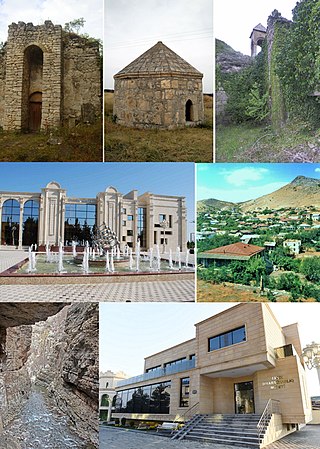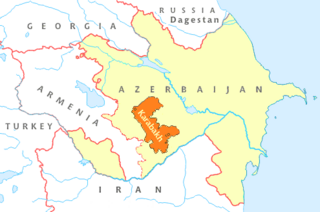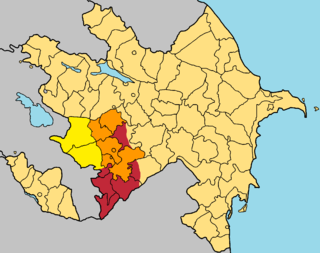
Artsakh, officially the Republic of Artsakh or the Republic of Nagorno-Karabakh, was a breakaway state in the South Caucasus whose territory was internationally recognised as part of Azerbaijan. Between 1991 and 2023, Artsakh controlled parts of the former Nagorno-Karabakh Autonomous Oblast of the Azerbaijani Soviet Socialist Republic, including its capital Stepanakert. It had been an enclave within Azerbaijan from the 2020 Nagorno-Karabakh war until the 2023 Azerbaijani offensive, when the Azerbaijani military took control over the remaining territory controlled by Artsakh. Its only overland access route to Armenia after the 2020 war was via the 5 km (3.1 mi) wide Lachin corridor, which was placed under the supervision of Russian peacekeeping forces.

Kalbajar District is one of the 66 districts of Azerbaijan. It is located in the west of the country and belongs to the East Zangezur Economic Region. The district borders the districts of Lachin, Khojaly, Agdam, Tartar, Goranboy, Goygol and Dashkasan districts of Azerbaijan, as well as the Gegharkunik and Vayots Dzor provinces of Armenia. Its capital and largest city is Kalbajar. As of 2020, the district had a nominal population of 94,100.

Tartar District is one of the 66 districts of Azerbaijan. It is located in the west of the country and belongs to the Karabakh Economic Region. The district borders the districts of Kalbajar, Goranboy, Yevlakh, Barda, and Aghdam. Its capital and largest city is Tartar. As of 2020, the district had a nominal population of 104,700. In March 2023, Azerbaijan began resettling the part of the district that was previously controlled by Armenian forces. Resettlement of the village by Azerbaijan began in March 2023, with 20 families moving back to Talish.

The Sarsang Reservoir is a reservoir located between the Tartar and Kalbajar districts of Azerbaijan. The reservoir was formed by the construction of a dam on the Tartar River. The overall volume of the reservoir is 575 million m3.
The OSCE Minsk Group was created in 1992 by the Conference on Security and Cooperation in Europe (CSCE), now Organization for Security and Co-operation in Europe (OSCE), to encourage a peaceful, negotiated resolution to the conflict between Azerbaijan and Armenia over Nagorno-Karabakh.

The Nagorno-Karabakh conflict was an ethnic and territorial conflict between Armenia and Azerbaijan over the region of Nagorno-Karabakh, inhabited mostly by ethnic Armenians until 2023, and seven surrounding districts, inhabited mostly by Azerbaijanis until their expulsion during the 1990s. The Nagorno-Karabakh region was entirely claimed by and partially controlled by the breakaway Republic of Artsakh, but was recognized internationally as part of Azerbaijan. Azerbaijan gradually re-established control over Nagorno-Karabakh region and the seven surrounding districts.

United Nations Security Council resolution 822 was adopted unanimously on 30 April 1993. After expressing concern at the deterioration of relations between Armenia and Azerbaijan, and the subsequent escalation of armed hostilities and deterioration in the humanitarian situation in the region, the Council demanded the immediate cessation of hostilities and the immediate withdrawal of Armenian occupying forces in the Kalbajar district near Nagorno-Karabakh in Azerbaijan.

United Nations Security Council resolution 874, adopted unanimously on 14 October 1993, reaffirmed sovereignty and territorial integrity of the Azerbaijani Republic and of all other States in the region, called for the preservation of the ceasefire, cessation of hostilities and withdrawal of forces from recently occupied districts of the Republic of Azerbaijan, and reaffirmed resolutions 822 (1993) and 853 (1993). The Council expressed its concern at "...the conflict in and around the Nagorny Karabakh region of the Azerbaijani Republic, and of the tensions between the Republic of Armenia and the Azerbaijani Republic...", and called upon the parties to observe the ceasefire agreed with by the government of Russia and OSCE Minsk Group.

The Sarsang Hydro Power Plant is a hydro power plant located in Tartar District of Azerbaijan. The power plant has an installed electric capacity of 50 megawatts (67,000 hp) on Sarsang reservoir, and provides 40-60% of the electricity consumed in the Republic of Artsakh. In 1990, the station generated 81.9 million kWh.

Lachin District is one of the 66 districts of Azerbaijan. It is located in the west of the country and belongs to the East Zangezur Economic Region. The district borders the districts of Kalbajar, Khojaly, Shusha, Khojavend, Qubadli, and the Syunik Province of Armenia. Its capital and largest city is Lachin. As of 2020, the district had a nominal population of 78,600.
The 2010 Mardakert clashes were a series of violations of the First Nagorno-Karabakh War ceasefire. They took place across the line of contact dividing Azerbaijan and the ethnic Armenian military forces of the unrecognized but de facto independent Nagorno-Karabakh Republic. Both sides accused the other of violating the ceasefire regime. These were the worst violations of the cease fire in two years and left Armenian forces with the heaviest casualties since the Mardakert clashes of March 2008.

The Tartar is one of the tributaries of the Kura located in Azerbaijan. It passes through the districts of Kalbajar, Barda and Tartar. Part of the river flows through the self-proclaimed Republic of Artsakh's Martakert Province.

The Madrid Principles were proposed peace settlements of the Nagorno-Karabakh conflict, proposed by the OSCE Minsk Group. As of 2020 the OSCE Minsk Group was the only internationally agreed body to mediate the negotiations for the peaceful resolution of the conflict. Senior Armenian and Azerbaijani officials have agreed on some of the proposed principles but have made little or no progress towards the withdrawal of Armenian forces from occupied territories or towards the modalities of the decision on the future Nagorno-Karabakh status.

United Nations General Assembly Resolution 62/243, titled "The Situation in the Occupied Territories of Azerbaijan", is a resolution of the United Nations General Assembly about the situation in Nagorno-Karabakh, which was adopted on March 14, 2008 at the 62nd session of the General Assembly. It became the seventh United Nations document concerning Nagorno-Karabakh and the third and last United Nations General Assembly document on it.
Council of Europe Parliamentary Assembly (PACE) Resolution 1416 (2005), titled “The conflict over the Nagorno-Karabakh region dealt with by the OSCE Minsk Conference”, is a resolution of PACE about the situation on occupied territories currently in the possession of Azerbaijan by Armenian military forces, adopted by PACE on January 25, 2005.

The political status of Nagorno-Karabakh remained unresolved from its declaration of independence from the Soviet Union on 10 December 1991, to its September 2023 collapse. During Soviet times, it had been an ethnic Armenian autonomous oblast of the Azerbaijan Soviet Socialist Republic. Following the dissolution of the Soviet Union, a conflict arose between local Armenians who sought to have Nagorno-Karabakh join Armenia and local Azerbaijanis who opposed this.

The 2016 Nagorno-Karabakh conflict, also known as the Four-Day War, April War, or April clashes, began along the former Nagorno-Karabakh line of contact on 1 April 2016 with the Artsakh Defence Army, backed by the Armenian Armed Forces, on one side and the Azerbaijani Armed Forces on the other.

Relations between Azerbaijan and the Organization for Security and Cooperation in Europe (OSCE) began when Azerbaijan joined OSCE’s predecessor, the Conference on Security and Cooperation in Europe (CSCE), on January 30, 1992. This was the first European organization Azerbaijan joined. The CSCE transformed into the OSCE shortly afterwards in 1995.

The 1st Army Corps, also referred to as the Barda Army Corps, is a regional military formation of the Azerbaijani Land Forces. It is considered to be the most dangerous, strategic post of the Armed Forces. Most of its units are located on the Armenian border with Nagorno-Karabakh. It is currently led by Major General Hikmat Hasanov. It is currently deployed from Barda, which is south of Yevlakh near Ganja.
The following is list of the official reactions to the Second Nagorno-Karabakh War.


















